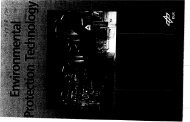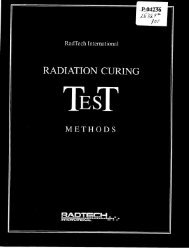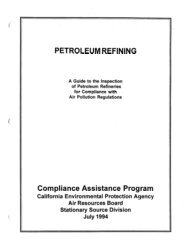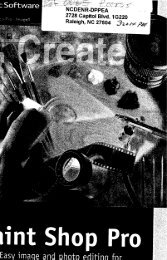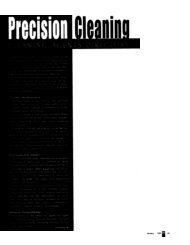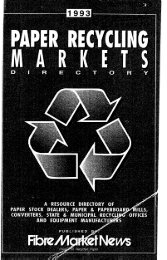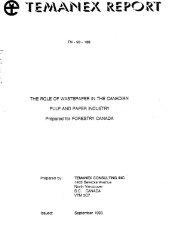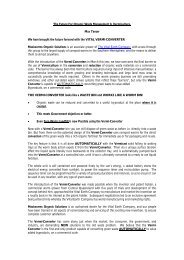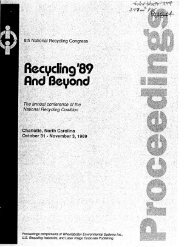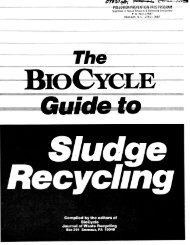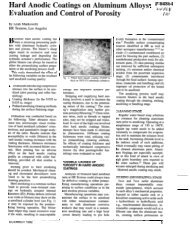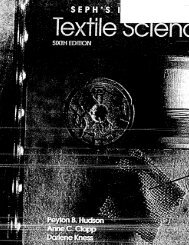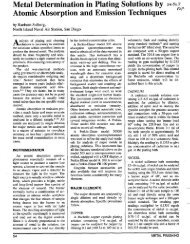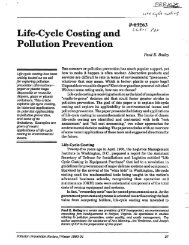Electronic Parts/Guidelines - infoHouse
Electronic Parts/Guidelines - infoHouse
Electronic Parts/Guidelines - infoHouse
You also want an ePaper? Increase the reach of your titles
YUMPU automatically turns print PDFs into web optimized ePapers that Google loves.
Compostabla: Unqualified claims of compostability are deceptive. Claims should be made only if all<br />
the materials in a package will break down into safe, usable compost. A distinction should be made as<br />
to whether an item is appropriate only for composing in municipal facilities and not in the home<br />
compost heap. All compostability claims should be scientifically substantiated.<br />
Recyclable: It is deceptive to misrepresent that a package is recyclable. Many materials are techni-<br />
cally recyclable. However, only packages that can be collected, separated and recovered from the<br />
waste stream and used in the manufacture of a new product or package should be described as<br />
recyclable. Where recycling of certain materials is limited or not available, or if a non-recyclable com-<br />
ponent “significantly limits” recyclability of an item that is made primarily of recyclable material, the<br />
claim should be avoided. Also, if the shape or size of a recyclable item makes it difficult or impossible<br />
to recycle, the claim should not be used.<br />
Recycled Content: It is deceptive to misrepresent that a package is made of recycled material. Pack-<br />
ages made only partly of recycled content, claims should be qualified by amount or weight. Recycled<br />
content claims should be used only for materials that have been recovered from the waste stream<br />
during manufacturing (pre-consumer) or afler consumer (post-consumer). If the recycled material used<br />
is pre-consumer, it must be substantiated that the pre-consumer material would have entered the solid<br />
waste stream had it not been recycled. That means if spills and scrap of a virgin material are typically<br />
collected and used for production, they do not qualify as recycled materials. If items contain both pre-<br />
and post-consumer recycled content, those differences may be noted, but only if the claimed differ-<br />
ences can be substantiated.<br />
Source Reduction: It is deceptive to misrepresent that a package is lower in weight, volume or toxicity<br />
than another package. Source reduction claims should be qualified. Comparisons with previous ver-<br />
Sions of the same package should be fully explained.<br />
Reflllabla: It is deceptive to misrepresent that a package is refillable. Unqualified refill claims may be<br />
made only if a collection and return system fro refills exists.<br />
SPI Symbol: The Society of the Plastics Industry (SPI) resin identification symbol (RIS), when used<br />
alone and placed inconspicuously on a package, does not constitute environmental advertising.<br />
5.2.3 Conclusions<br />
Making environmental packaging claims is a complex issue that should only be done If the claims can<br />
be substantiated. In the electronic industty there is little benefit to making environmental packaging<br />
claims and therefore they should be avoided.<br />
5.2.4 Recommendation<br />
It is IBM’s position not to use environmental packaging claims, such as the recyclable symbol, as a<br />
marketing tool, but rather to provide information by displaying the appropriate symbology to the con-<br />
sumer so that the best disposal decision can be made. The preferred location on IBM packages for all<br />
symbology is on the bottom of the container or similar inconspicuous spot.<br />
44 Environmental Packaaina <strong>Guidelines</strong>



